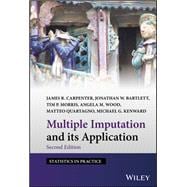The most up-to-date edition of a bestselling guide to analyzing partially observed data
In this comprehensively revised Second Edition of Multiple Imputation and its Application, a team of distinguished statisticians delivers an overview of the issues raised by missing data, the rationale for multiple imputation as a solution, and the practicalities of applying it in a multitude of settings.
With an accessible and carefully structured presentation aimed at quantitative researchers, Multiple Imputation and its Application is illustrated with a range of examples and offers key mathematical details. The book includes a wide range of theoretical and computer-based exercises, tested in the classroom, which are especially useful for users of R or Stata. Readers will find:
- A comprehensive overview of one of the most effective and popular methodologies for dealing with incomplete data sets
- Careful discussion of key concepts
- A range of examples illustrating the key ideas
- Practical advice on using multiple imputation
- Exercises and examples designed for use in the classroom and/or private study
Written for applied researchers looking to use multiple imputation with confidence, and for methods researchers seeking an accessible overview of the topic, Multiple Imputation and its Application will also earn a place in the libraries of graduate students undertaking quantitative analyses.








